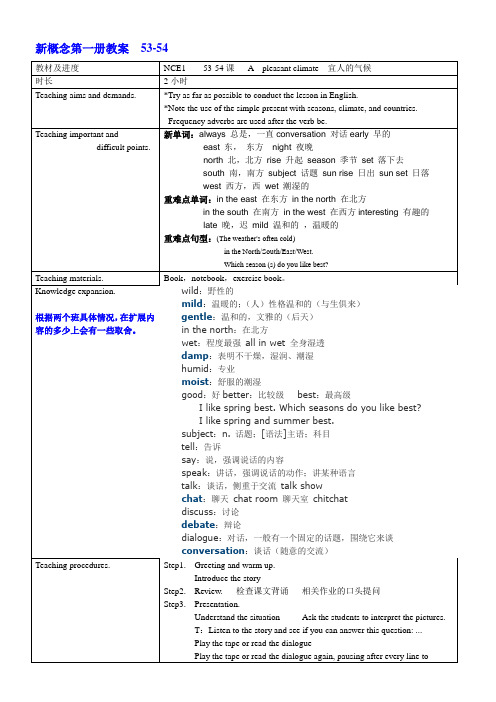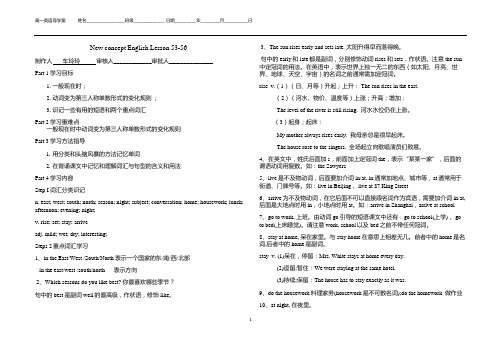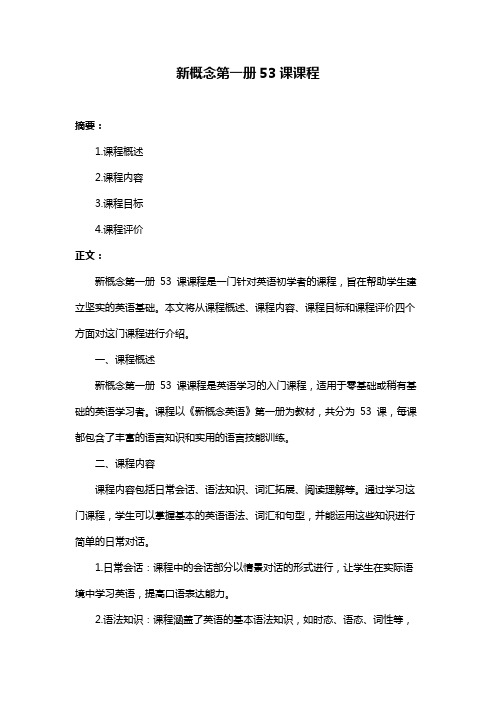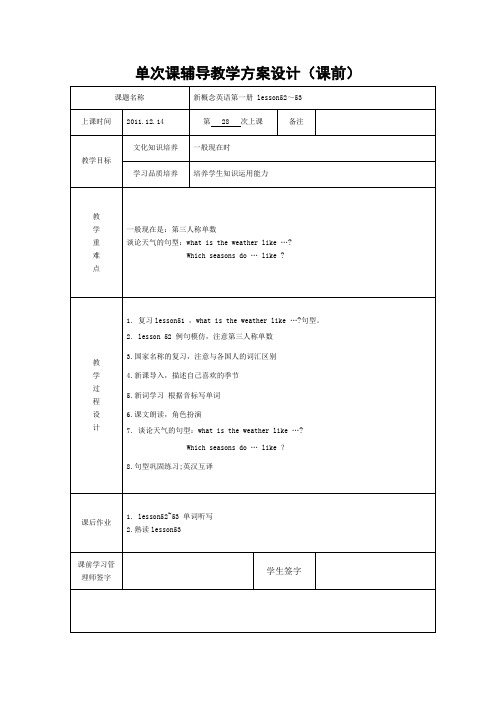最新新概念英语第一册第53课教学设计word版本
新概念第一册教案 53-54

新概念第一册教案53-54教材及进度NCE1 53-54课 A pleasant climate 宜人的气候时长2小时Teaching aims and demands. *Try as far as possible to conduct the lesson in English.*Note the use of the simple present with seasons, climate, and countries.Frequency adverbs are used after the verb be.Teaching important anddifficult points. 新单词:always 总是,一直conversation 对话early 早的east 东,东方night 夜晚north 北,北方rise 升起season 季节set 落下去south 南,南方subject 话题sun rise 日出sun set 日落west 西方,西wet 潮湿的重难点单词:in the east 在东方in the north 在北方in the south 在南方in the west 在西方interesting 有趣的late 晚,迟mild 温和的,温暖的重难点句型:(The weather's often cold)in the North/South/East/West.Which season (s) do you like best?Teaching materials. Book,notebook,exercise book。
Knowledge expansion.根据两个班具体情况,在扩展内容的多少上会有一些取舍。
wild:野性的mild:温暖的;(人)性格温和的(与生俱来)gentle:温和的,文雅的(后天)in the north:在北方wet:程度最强all in wet 全身湿透damp:表明不干燥,湿润、潮湿humid:专业moist:舒服的潮湿good:好better:比较级best:最高级I like spring best. Which seasons do you like best?I like spring and summer best.subject:n. 话题;[语法]主语;科目tell:告诉say:说,强调说话的内容speak:讲话,强调说话的动作;讲某种语言talk:谈话,侧重于交流talk showchat:聊天chat room 聊天室chitchatdiscuss:讨论debate:辩论dialogue:对话,一般有一个固定的话题,围绕它来谈conversation:谈话(随意的交流)Teaching procedures. Step1. Greeting and warm up.Introduce the storyStep2. Review. 检查课文背诵相关作业的口头提问Step3. Presentation.Understand the situation Ask the students to interpret the pictures.T:Listen to the story and see if you can answer this question: ...Play the tape or read the dialoguePlay the tape or read the dialogue again, pausing after every line tocheck the students understand.Play the tape or read the dialogue again, pausing after every line,and ask the students to repeat(a) in chorus,(b) in small groups,(c) individually.Reading aloudAsk one or two students to take parts and to read the dialogue aloud.Step4. Practice.Step5. Summary. Asking questionsStep6. Homework.Reflection. 1.advantage2.disadvantageBoard design。
新概念第一册第53-54课课件

循序渐进
教材按照由浅入深、循序渐进的原则编排, 适合不同水平的英语学习者。
综合训练
通过听、说、读、写等多种训练方式,全面 提高学习者的英语能力。
第53-54课内容概述
01
02
03
课文主题
介绍两位著名人物及其成 就。
语言点
本课涉及一些新的词汇和 表达方式,如“be known as”、“make a contribution to”等。
02
03
自由表达
提供主题或话题,让学生自由发 挥,进行口语表达练习,培养他 们的思维能力和创造力。
04
06
阅读理解与写作技能提升
相关主题文章阅读推荐
经典童话故事
选择适合学生年龄段的经典童话故事,如《小红帽》、《灰姑娘》 等,通过阅读这些故事,培养学生的阅读兴趣和理解能力。
生活类短文
选取与学生日常生活相关的短文,如学校生活、家庭生活、朋友相 处等,引导学生将阅读与生活实际相结合,提高阅读实用性。
等。
02
社交习惯差异
探讨中西方在社交习惯方面的不同,如问候方式、称呼方式、送礼习俗
等。
03
时间观念差异
分析中西方在时间观念上的差异,如守时与灵活、计划性与随机性等。
跨文化交际能力培养
语言交际能力
提高英语听说读写能力,培养用英语进行日常交际和跨文 化交际的能力。
文化适应能力
增强对不同文化背景下行为规范的认知和适应能力,避免 文化冲突和误解。
句子结构分析及语法点讲解
简单句和复合句
定语从句
本课课文中出现多种句型,包括简单 句和复合句。简单句由一个主语和一 个谓语构成,而复合句则包含一个主 句和一个或多个从句。
新概念一lesson53-56学案

New concept English Lesson 53-56制作人车玲玲审核人_____________审批人_______________Part 1 学习目标1.一般现在时;2.动词变为第三人称单数形式的变化规则;3.识记一些有用的短语和两个重点词汇Part 2 学习重难点一般现在时中动词变为第三人称单数形式的变化规则Part 3 学习方法指导1.用分类和头脑风暴的方法记忆单词2.在背诵课文中记忆和理解词汇与句型的含义和用法Part 4 学习内容Step I 词汇分类识记n. east; west; south; north; season; night; subject; conversation; home; housework; lunch; afternoon; evening; night;v. rise; set; stay; arriveadj. mild; wet; dry; interesting;Steps 2重点词汇学习1、in the East/West /South/North表示一个国家的东/南/西/北部in the east/west /south/north 表示方向2、Which seasons do you like best? 你最喜欢哪些季节?句中的best是副词well的最高级,作状语,修饰like。
3、The sun rises early and sets late. 太阳升得早而落得晚。
句中的early和late都是副词,分别修饰动词rises和sets,作状语。
注意the sun 中定冠词的用法。
在英语中,表示世界上独一无二的东西(如太阳、月亮、世界、地球、天空、宇宙)的名词之前通常需加定冠词。
rise v.(1)(日、月等)升起;上升: The sun rises in the east.(2)(河水、物价、温度等)上涨;升高;增加:The level of the river is still rising. 河水水位仍在上涨。
新概念第一册53课课程

新概念第一册53课课程摘要:1.课程概述2.课程内容3.课程目标4.课程评价正文:新概念第一册53 课课程是一门针对英语初学者的课程,旨在帮助学生建立坚实的英语基础。
本文将从课程概述、课程内容、课程目标和课程评价四个方面对这门课程进行介绍。
一、课程概述新概念第一册53 课课程是英语学习的入门课程,适用于零基础或稍有基础的英语学习者。
课程以《新概念英语》第一册为教材,共分为53 课,每课都包含了丰富的语言知识和实用的语言技能训练。
二、课程内容课程内容包括日常会话、语法知识、词汇拓展、阅读理解等。
通过学习这门课程,学生可以掌握基本的英语语法、词汇和句型,并能运用这些知识进行简单的日常对话。
1.日常会话:课程中的会话部分以情景对话的形式进行,让学生在实际语境中学习英语,提高口语表达能力。
2.语法知识:课程涵盖了英语的基本语法知识,如时态、语态、词性等,帮助学生建立完整的语法体系。
3.词汇拓展:课程精选了大量常用词汇,通过例句和短文的形式进行讲解,帮助学生掌握词汇的用法。
4.阅读理解:课程中的阅读材料丰富多样,既有故事又有科普文章,让学生在提高阅读能力的同时,拓宽视野。
三、课程目标新概念第一册53 课课程的目标是培养学生的英语基本功,使他们在听、说、读、写四个方面取得全面进步。
1.听力:能听懂简单的英语对话,理解日常用语。
2.口语:能用简单的英语进行自我介绍和日常交流。
3.阅读:能阅读简单的英语文章,理解文章大意。
4.写作:能用所学词汇和句型进行简单的书面表达。
四、课程评价新概念第一册53 课课程是一门实用的英语入门课程,得到了广大学习者的认可。
课程内容丰富,教学方法生动有趣,能有效帮助学生提高英语水平。
然而,课程也存在一定的局限性,例如部分语法知识点讲解不够深入,需要学生在课后进行补充学习。
新概念英语第一册第53课课件教案资料

无忧PPT整理发布
season
There are four seasons in a year.
spring summer autumn winter
无忧PPT整理发布
无忧PPT整理发布
England
the Great Britain
Ireland
and Northern
( ) Jim doesn’t like autumn and
winter, because the sun rises late
and sets early.
( ) Climate is English favorite subject
of conversation.
无忧PPT整理发布
四、复述课文
Scotland
England
Welsh
Northern Ireland
无忧PPT整理发布
conversation n. 谈话
say
说话的内容
speak 讲话的动作
talk
谈话,聊天
chat
聊天
dialog 对话—有固定的话题
conversation 谈话(随意型及语法
1. 总的说明英国的气候 2. 分别说明各个地区气候 3. Jim喜欢和不喜欢的季节
及原因 4. 总结性地说出天气是英国人喜欢
谈论的话题
无忧PPT整理发布
See you !
无忧PPT整理发布
此课件下载可自行编辑修改,仅供参考! 感谢您的支持,我们努力做得更好!谢谢
无忧PPT整理发布
My favourite season is spring. Because ...
新概念第一册53课Lesson53完整 (2)

动词原形变第三人称单数的规则与发音规律同
名词单数变复数大致相同
1、大多数动词在词
①stop-stops ②read-reads
[s] ; make-makes [s]
[z] ; play-plays [z]
动词第三人称单数
always 总是(频率副词从大到小) 一直 usually 通常 often 经常 sometimes 有时 seldom 很少 never 从不 频率副词位置:be动词、助动词、情态动词 后,实意动词前(三词后,一词前)
always
方位的表达
north N east E west W
1. 我们每天都 喝牛奶。 Every day we drink milk. 2.我们总在下午上英语课。 We always have English classes in the afternoon. 3.她通常下课后打篮球。 She usually plays basketball after school.
Present simple tense
*频率副词频率大小排列
always>usually>often>sometimes 用于一 般现在时
Things are always 1. 客观事实
一 We are boys. 般 The moon goes round 现 在 the earth. 时 Things are true now 的 2. 符合现在事实情况 三 种 You are 17. 用 He is a student. 法
2、以辅音字母加“y”结尾的,要先将“y”变为 “i”,然后在加“es”读[iz] 如 fly-flies [z]; carry-carries [z] study-studies [z]; worry-worries 3、以“s, x, ch, sh”结尾的,在词尾加“es”,发 音为[iz] 如:
新概念英语第一册lesson52~53教案

上次作业完成情况:数量_100_%,完成质量_80_分 存在问题_单词___
学生课堂表现及师生沟通情况
根据该同学的上课表现,课文还不够熟练。同时单词听写还要下功夫,以后会给单词听写打分,以此提高学生记单词的积极性。本次上课的内容是上节课的延伸,学生对上节课的知识遗忘,所以花了部分时间在复习上,本堂课对新课主要是完成词汇教学部分,学生完成的还是不错,基本能掌握拼读及意思,需要学生课后巩固。
学生讨论情况或回访跟踪情况
教学计划完成情况备注
改进意见
学习管理师签字
上级签字
Which seasons do…like?
8.句型巩固练习;英汉互译
课后作业
1. lesson52~53单词听写
2.熟读lesson53
课前学习管理师签字
学生签字
课后跟踪表
课
时
质
量
跟
踪
情
况
记
录
本节课教学计划完成情况:照常完成()提前完成()延后完成(√ )
学生接受程度:完全接受(√) 部分接受() 不能接受()
单次课辅导教学方案设计(课前)
课题名称
新概念英语第一册lesson52~53
上课时间
2011.12.14
第28次上课
备注
教学目标
文化知识培养
一般现在时
学习品质培养
培养学生知识运用能
一般现在是:第三人称单数
谈论天气的句型:what is the weather like…?
Which seasons do…like ?
教
学
过
程
设
计
新概念第一册第53课

主语+谓语+间接宾语+直接宾语(SVOi…
句子中包含两个宾语,间接宾语通常表示人,直接宾语表示物。
并列句和复合句应用
并列句
由并列连词连接的两个或两个以上的 简单句构成,各分句之间地位平等, 没有从属关系。
并列句与复合句的转换
通过添加从属连词或将并列连词替换 为从属连词,可以将并列句转换为复 合句,或将复合句拆分为并列句。
情态动词must和have to的用法区别 :must表示主观上的必须,而have to表示客观上的必须。
反身代词的用法:反身代词通常与动 词连用,表示动作作用于主语本身。
04 听力技巧与训练 建议
听力材料选择策略
01
02
03
选择真实场景对话
优先选择日常生活、学习 、工作中的真实对话,以 便更好地理解和运用语言 。
比……有优势,用于比较两个或多个事物之 间的优劣。
a great deal of
大量的,用于修饰不可数名词,表示数量很 多。
take part in
参加,指加入某种活动或组织中。
be successful in
在……方面成功,用于描述在某方面取得成 功的情况。
拓展词汇及表达方式
benefit
利益、好处,与 `advantage`意思相 近,但更强调获得的 实际利益。
复合句
由一个主句和一个或一个以上的从句 构成,从句在句中作主句的某个成分 ,从句与主句之间有从属关系。
重点语法点剖析
现在完成时态:表示过去发生的动作 对现在造成的影响或结果,常与 already,yet,just等副词连用。
感叹句的构成及用法:通过将主语和 谓语颠倒顺序并在前面加上感叹词 what或how来构成感叹句,表达强 烈的感情。
(完整版)新概念第一册第53-54课课件

north n.北方
northern /'nɔːðən/ adj. 北方的
The weather’s often cold in the North.
北部的天气常常很寒冷。
The park is in the northern part of the city. 公园位于该城市的北部。
east n.东方
We live in the southern part of China.
我们住在中国的南部。
northwest
North
West
northeast
East
southwest
South
southeast
wet adj.潮湿的
• adj. 多雨的;雨天的 • It’s often wet in the west.
eastern /'iːst(ə)n/ adj. 东方的
It’s often windy in the East.
东部常常刮风。
I live in the eastern part of the city. 我住在城市的北部。
west n. 西方
western /'westən/ adj. 西方的
Lesson53
An interesting climate
mild adj.温和的,温暖的
The weather is mild today. 今天天气很温暖. It’s mild, but it’s not always pleasant. 气候温和,但也不总是宜人的。
• gentle : 指温柔、亲切、优雅。 常含有节制的意味。
太阳在西边落下。
Listen and answer
新概念英语第一册第53课

Practicality
The content of the textbook is close to daily life and work scenarios, emphasizing the cultivation of learners' practical language proficiency.
Practice
Practice speaking and writing more, such as imitating dialogues, writing dialogues similar to scenes, etc., to deepen the understanding and memory of the learned content.
In addition, students can also learn about the shopping culture and habits of different countries and regions through this lesson, as well as how to use appropriate language and expressions in different situations.
02 Example sentence: Examples of usage in specific contexts
Key vocabulary explanation and example sentences
Vocabulary 3
Example
sentence:
Examples of usage in
Common Phrase Pairing and Usage
新概念英语第53课教案

Lesson 53 Hot snake上课时间:上课地点:教学用书:新概念二教学目标: ①掌握生词和短语cause cause sb to do sth remainssolve……②掌握现在完成进行时与现在完成时用法教学重难点:现在完成进行时与现在完成时用法及区别教学过程:阅读文章回答问题1、What are forest fires often caused by ?2、What led the fireman to discover the cause of the fire?3、What was the explanation?一、单词教学1.hot adj 热的,炎热的It is very hot today. 今天很热。
Strike while the iron is hot.趁热打铁.hot 炎热的warm 温暖的cool 凉爽的chilly 寒冷的cold 寒冷的,严寒的2.调味品辣的Pepper and mustard are hot.辣椒和芥末是辣的.强烈的,激烈的,热烈的.have a hot temper 脾气暴躁a hot potato 棘手或讨厌的事物或情况2.cause(1)V. 引起cause sth : 引起(麻烦)Carelessness causes accidents.粗心导致事故Pride causes failure骄傲使人失败cause sb to do sth引起某人做某事, 导致某人做某事2)n. 原因cause : 强调事情发生的直接原因(一个)Do you know the reason of the war?你知道这场战争发生的原因么?reason : 其他各种的理由(很多个)Give me your reasons for going there.请告诉我你去那里的原因。
3.★examine1)v. 仔细观察,检查,调查The firefighters examined every inch of the forest.消防队员检查了森林的每一寸土地。
新概念英语第一册第53课教学文案

英国:大不列巅及 北爱尔兰联合王国
England 英格兰 Scotland 苏格兰 Northern Ireland 北爱尔兰 Wales 威尔士
Ireland 爱尔兰
north
1.What is the favourite subject of conversation in
England?
2.What's the climate like in England?
Lesson 53 An interesting climate
New words and new expressions:
Spring Summer Autumn Winter
What’s the weather like in the North? It’s cold in the North.
What’s the weather like in the East? It’s windy in the East.
What’s the weather like in the West? It’s wet in the West.
north
east east [iːst] n. 东方
west
west [west] n. 西方
in the east 在东方
in the west 在西方
go west 去死south south [sauθ] n. 南方
in the south 在南方
North
In
West
East
South
season [‘si:zən] n. 季节
- 1、下载文档前请自行甄别文档内容的完整性,平台不提供额外的编辑、内容补充、找答案等附加服务。
- 2、"仅部分预览"的文档,不可在线预览部分如存在完整性等问题,可反馈申请退款(可完整预览的文档不适用该条件!)。
- 3、如文档侵犯您的权益,请联系客服反馈,我们会尽快为您处理(人工客服工作时间:9:00-18:30)。
新概念第一次第53课教案设计
课型:New lesson
一、教学内容与目的要求:
1、Learn Lesson 53 An interesting climate
2、Learn Simple Present.
3、Learn the exercise of Passage 8 in PETS (1B).
4、Review the Phonetic Symbols.
二、重点句型及重点单词、词语:
Phrases: in the East/West /South/North表示一个国家的东/南/西/北部
in the east/west /south/north 表示方向
太阳升起用rise,太阳降落用set.
Structure: Where do you come from?
I come from .
Which do you like best?
三、教学难点:
一般现在时中主语为第三人称单数时的动词加S
(5)教学准备:
①Recorder ②tape ③phonogram cards ④word cards ⑤stars ⑥poster ⑦phonetic symbol cards ⑧teaching plan ⑨教学流程表⑩Pictures
四、教学程序及教学游戏安排:
StepⅠ:Warming up exercise
1.Genral greeting
1> How is the weather?
2>Who cooks breakfast for you?
3>Which animals do you like more, bears or pandas?
4>What do you usually do on Sunday mornings?
5>In which month is our National Day?
StepⅡ: Revision
Review the Phonograms, the Phonetic Symbols and the words.
flash cards
Pass cards
StepⅢLearn Lesson 25 <Mrs. Smith’s kitchen>
1.Learn new words
mild always season east west south north rise set interesting subject conversation climate certainly pleasant favourite
(根据福尼斯英语的单词教学步骤进行课文中新单词的教学。
)
①T sounds the words 3 times.
②T makes sentences with the words and Ss guess the meaning.
③Ss write the words in their notebooks.
④T checks the words.
⑤Ss read the words together.
⑥Ss listen to the words tape and translate the sentences with the new words.(训练学生的听力及理解能力)
⑦ Game: Direction games
2.Learn the text.
①Introduce the story.
T: Today we’re going to talk about the weather in England.
②Understand the situation.
Ask Ss to interpret the picture.
③Listen to the object.
T: Listen to the story and see if you can answer this question:
Where is the Jones family?
④Intensive reading and understand the text.
Play the tape or read the dialogue again, pausing after every line to check the students understand.
Phrases: in the East/West /South/North表示一个国家的东/南/西/北部
in the east/west /south/north 表示方向
太阳升起用rise,太阳降落用set.
Structure: Where do you come from?
I come from .
Which do you like best?
Game: 击鼓传花:传到的小朋友选一纸条,纸上有国家名称和主语,请小朋友马上组成对话:Where come from?
come(s) from .
⑤Ask questions.
⑥Do translations. (English to Chinese and Chinese to English.)
⑦Ss ask T questions.
Review the question words: why what where which who how
T ask Ss to ask T questions according to the text.
⑧Little Journalist.(the more the better.)
StepⅢ Grammar
1 Learn Simple Present.
1>引出一般现在时
基本用法:一般现在时表示经常发生的事情或者经常存在的状态动词表示动作和状态的词。
es(或变y为i加es
Mum cooks in the kitchen.
The cat catches the mouse.
The little girl carries a big stone.
①一般情况下由动词原形加s构成: He sings well.
Leah likes English very much.
Leah loves you.
She dances.
②以o, z, s, ch, sh, x等到字母结尾的动词,加es。
如pushes, mixes,
passes
The cat catches a lot of mice.
Leah washes her clothes at home.
She watches TV on Sundays.
Frank passes the card to Leah.
③以辅音字母加y结尾的动词,将y变i,再加es。
如cry—cries
try—tries
A bird flies in the sky.
She cries loudly.
Leah studies English everyday. 注意:play的变化----虽是y结尾但结尾直接加s即可。
go, do, have
不规则变化。
4>Do the exercise on P1 of NCE.
StepⅣConclusion
1 Sound and read words together and tell the rules .
2 Tell parents important and difficult points.
3 Praise Ss who have the best attitude in the class.
4 Homework。
